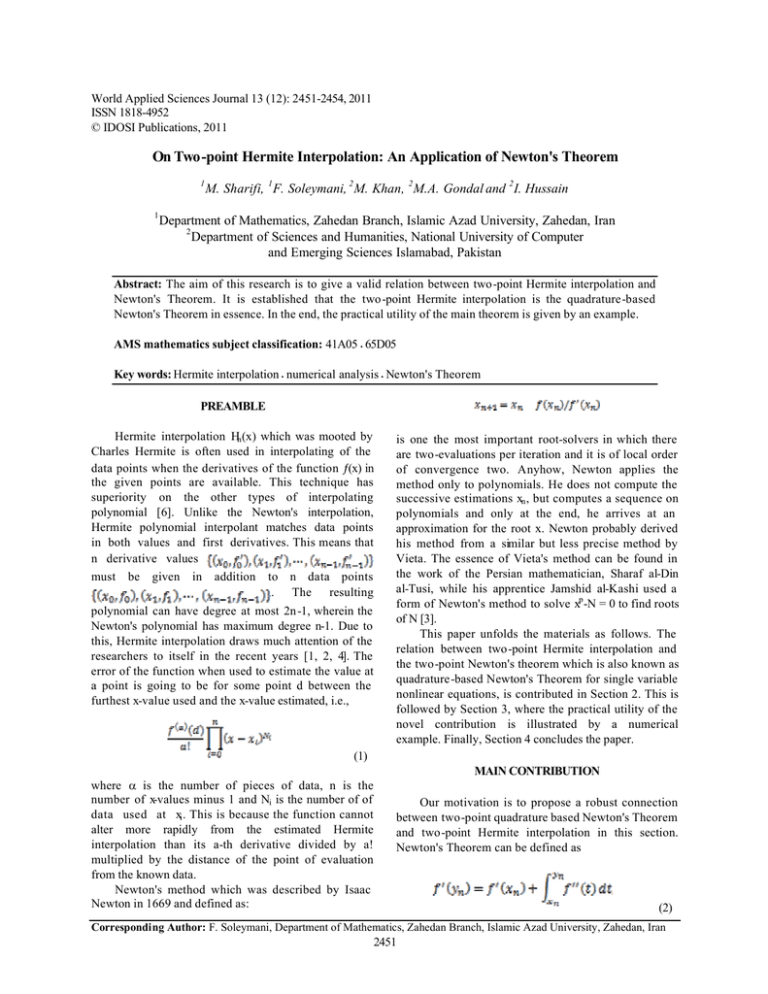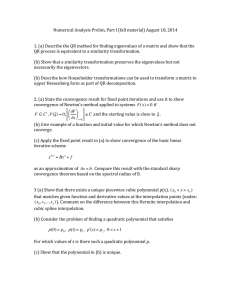On Two-point Hermite Interpolation: An Application of Newton`s
advertisement

World Applied Sciences Journal 13 (12): 2451-2454, 2011 ISSN 1818-4952 © IDOSI Publications, 2011 On Two-point Hermite Interpolation: An Application of Newton's Theorem 1 1 1 2 2 2 M. Sharifi, F. Soleymani, M. Khan, M.A. Gondal and I. Hussain Department of Mathematics, Zahedan Branch, Islamic Azad University, Zahedan, Iran 2 Department of Sciences and Humanities, National University of Computer and Emerging Sciences Islamabad, Pakistan Abstract: The aim of this research is to give a valid relation between two-point Hermite interpolation and Newton's Theorem. It is established that the two-point Hermite interpolation is the quadrature-based Newton's Theorem in essence. In the end, the practical utility of the main theorem is given by an example. AMS mathematics subject classification: 41A05 65D05 • Key words: Hermite interpolation numerical analysis Newton's Theorem • • PREAMBLE Hermite interpolation Hn (x) which was mooted by Charles Hermite is often used in interpolating of the data points when the derivatives of the function ƒ(x) in the given points are available. This technique has superiority on the other types of interpolating polynomial [6]. Unlike the Newton's interpolation, Hermite polynomial interpolant matches data points in both values and first derivatives. This means that n derivative values must be given in addition to n data points . The resulting polynomial can have degree at most 2n-1, wherein the Newton's polynomial has maximum degree n-1. Due to this, Hermite interpolation draws much attention of the researchers to itself in the recent years [1, 2, 4]. The error of the function when used to estimate the value at a point is going to be for some point d between the furthest x-value used and the x-value estimated, i.e., is one the most important root-solvers in which there are two-evaluations per iteration and it is of local order of convergence two. Anyhow, Newton applies the method only to polynomials. He does not compute the successive estimations xn , but computes a sequence on polynomials and only at the end, he arrives at an approximation for the root x. Newton probably derived his method from a similar but less precise method by Vieta. The essence of Vieta's method can be found in the work of the Persian mathematician, Sharaf al-Din al-Tusi, while his apprentice Jamshid al-Kashi used a form of Newton's method to solve xp -N = 0 to find roots of N [3]. This paper unfolds the materials as follows. The relation between two -point Hermite interpolation and the two-point Newton's theorem which is also known as quadrature-based Newton's Theorem for single variable nonlinear equations, is contributed in Section 2. This is followed by Section 3, where the practical utility of the novel contribution is illustrated by a numerical example. Finally, Section 4 concludes the paper. (1) where α is the number of pieces of data, n is the number of x-values minus 1 and Ni is the number of of data used at xi . This is because the function cannot alter more rapidly from the estimated Hermite interpolation than its a-th derivative divided by a! multiplied by the distance of the point of evaluation from the known data. Newton's method which was described by Isaac Newton in 1669 and defined as: MAIN CONTRIBUTION Our motivation is to propose a robust connection between two-point quadrature based Newton's Theorem and two-point Hermite interpolation in this section. Newton's Theorem can be defined as (2) Corresponding Author: F. Soleymani, Department of Mathematics, Zahedan Branch, Islamic Azad University, Zahedan, Iran 2451 World Appl. Sci. J., 13 (12): 2451-2454, 2011 wherein are two data points. imply Theorem 1: If the function ƒ has first and second derivatives in the real open domain D = (a,b) and , be two data points. and Therefore, Then the solution obtained by Hermite polynomial for ƒ′(y n ) is equal to the estimation attained by Newton's Theorem. . Similarly, from the second equation of (4) we have Proof: First, we construct the Hermite interpolation polynomial H(t) = ƒ(t) for estimating the (((yn) by taking into account that this approximation polynomial meets the function (on two points as follows: where C is constant. The condition implies The H(x) could be defined by . Ccordingly (3) where the interpolation basis functions w0 (x), w1 (x) are are quadratic polynomial functions that . From the third equation of (4), we attain satisfy in the conditions below wherein D is constant and by condition (4) we obtain From the first equation of (4), we attain Thus where A, B are constant. The conditions w0 (xn ) = 1 and With the specific expressions of the interpolation basis functions w0 (x), w1 (x) and we get that (5) An approximation of ƒ′(y n ) is then found by (6) Now we apply the Newton's Theorem (2) for finding an approximation of ƒ′(y n ). We assume the integral in (2) is estimated by a combination of known values, i.e., ƒ(xn ), ƒ(y n ), ƒ′(xn ) in the following form (7) 2452 World Appl. Sci. J., 13 (12): 2451-2454, 2011 At this time, the main challenge is to obtain the real-valued parameters α, β and γ as efficient as possible. Hopefully by considering the validness of the equation (7) in the following three equations NUMERICAL EXAMPLE (8) We can attain the three unknown real parameters. As a matter of fact, we substituting the known values in (8), then we have a linear system of three equations with three unknowns as follows (9) By solving the system of linear equations (9), we attain In this section, we pay attention to the practical application of the estimation obtained by Theorem 1. One of the most applicable situations in which we use the Newton's Theorem or Hermite interpolation is in construction of optimal two-point root-solvers for solving one variable nonlinear equations. It is widely known that the one-point Newton's iterative method has quadratically convergence with 1.414 as its efficiency index. To build higher order methods, two or three step cycles have been taken into consideration by authors; see e.g. [7] and the references therein, as follows (10) Hence, by considering (10) in (7) we have (13) (14) By using the estimation obtained in (13), we could obtain the following two-step iterative method of order four and with 1.587 as its efficiency index (11) and finally by using (11) in (2), an approximation for (((yn) is obtained in the form below (12) Now we have a powerful estimation of (((yn) which is obtained by quadrature based Newton's Theorem and is completely equal to the approximation attained by the two-point Hermite interpolation. This ends the proof. Note that using divided differences; we can simplify the approximation more in the following form (15) Remark 1: The optimal fourth-order scheme (15) is the two-step fourth-order method of Ostrowski [5] in essence. One way to check this finding is to write the error equation of (15). Using symbolic calculations and writing the Taylor expansion of any term involved in (15) around the root in the nth iterate, gives its asymptotic constant and the error equation in the following form (16) which is the error equation of Ostrowski's method as well. The Ostrowski's scheme is defined by 2453 (17) World Appl. Sci. J., 13 (12): 2451-2454, 2011 We here remark that this finding is also can be presented by simplifying the relation (15) to obtain (17). Therefore, we have (18) This shows that (15) and (17) are same and completes our finding. CONCLUSION A Theorem in regards to a sound relation between two-point Hermite interpolation and quadrature-based Newton's Theorem has investigated. The practical utility of the obtained approximation has given and applied for producing an accurate optimal two -point root-solver. In the end, it has also been shown that the novel approximations of the two-point Hermite interpolation and quadrature-based Newton's theorem which are equal, provide the Ostrowski's method in root-finding. REFERENCES 1. Berriochoa, E. and A. Cachafeiro, 2010. Algorithms for solving Hermite interpolation problems using the Fast Fourier Transform. J. Comput. Appl. Math., 235: 882-894. 2. Butcher, J.C., R.M. Corless, L. Gonzalez-Vega and A. Shakoori, 2010. Polynomial algebra for Birkhoff interpolants. Numer. Algor. doi: 10.1007/s11075010-9385-x. 3. Knapp, M.P. and C. Xenophontos, 2010. Numerical Analysis meets Number Theory: Using rootfinding methods to calculate inverse mod pn . Appl. Anal. Discrete Math., 4: 23-31. 4. Moukoko, D. and J. Dzoumba, 2005. Newton form of Hermite interpolation polynomial. Far East J. Math. Sci. (FJMS), 17: 107-120. 5. Ostrowski, A.M., 1973. Solution of equations in Euclidean and Banach space. Academic Press, New York. 6. Quarteroni, A., R. Sacco and F. Saleri, 2000. Numerical Mathematics, Springer. 7. Soleymani, F., 2010. Revesit of Jarratt method for solving nonlinear equations. Numer. Algor., doi: 10.1007/s11075-010-9433-6. 2454


